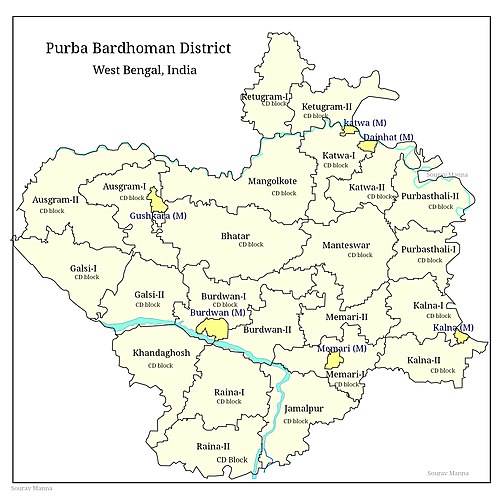Population
As per the 2011 Census of India Raina I CD Block had a total population of 180,952, of which 173,094 were rural and 7,858 were urban. There were 92,392 (51%) males and 88,560 (49%) females. Population below 6 years was 18,734. Scheduled Castes numbered 62,151 (34.35%) and Scheduled Tribes numbered 10,503 (5.80%). [9]
As per 2001 census, Raina I block had a total population of 162,921, out of which 83,633 were males and 79,288 were females. Raina I block registered a population growth of 13.71 per cent during the 1991-2001 decade. Decadal growth for Bardhaman district was 14.36 per cent. [10] Decadal growth in West Bengal was 17.84 per cent. [11] Scheduled castes at 54,462 formed around one-third the population. Scheduled tribes numbered 9,808. [12]
Census Town in Raina I CD Block is (2011 census figure in brackets): Seharabazar (7,858). [9]
Large villages (with 4,000+ population) in Raina I CD Block are (2011 census figures in brackets): Rayna (5,157), Jotsadi (4,998), Bantir (5,176), Haripur (4,992), Shyamsundar (4,903) and Dharan (4,403). [9]
Other villages in Raina I CD Block include (2011census figures in brackets): Mugura (1,867), Palasan (3,917), Hijalgram (1,685), Narugram (3,226) and Natu (1,626). [9]
Literacy
As per the 2011 census the total number of literates in Raina I CD Block was 130,093 (80.20% of the population over 6 years) out of which males numbered 71,005 (85.77% of the male population over 6 years) and females numbered 59,088 (74.38% of the female population over 6 years). The gender disparity (the difference between female and male literacy rates) was 11.39%. [9]
As per 2001 census, Raina I block had a total literacy of 74.69 per cent for the 6+ age group. While male literacy was 83.01 per cent female literacy was 65.88 per cent. Bardhaman district had a total literacy of 70.18 per cent, male literacy being 78.63 per cent and female literacy being 60.95 per cent. [13]
See also – List of West Bengal districts ranked by literacy rate
Languages and religion
In the 2011 census Hindus numbered 127,978 and formed 70.72% of the population in Raina I CD Block. Muslims numbered 51,443 and formed 28.43% of the population. Christians numbered 108 and formed 0.06% of the population. Others numbered 1,423 and formed 0.79% of the population. [14]
In Bardhaman district the percentage of Hindu population has been declining from 84.3% in 1961 to 77.9% in 2011 and the percentage of Muslim population has increased from 15.2% in 1961 to 20.7% in 2011. [15]
At the time of the 2011 census, 95.08% of the population spoke Bengali and 4.25% Santali as their first language. [16]

